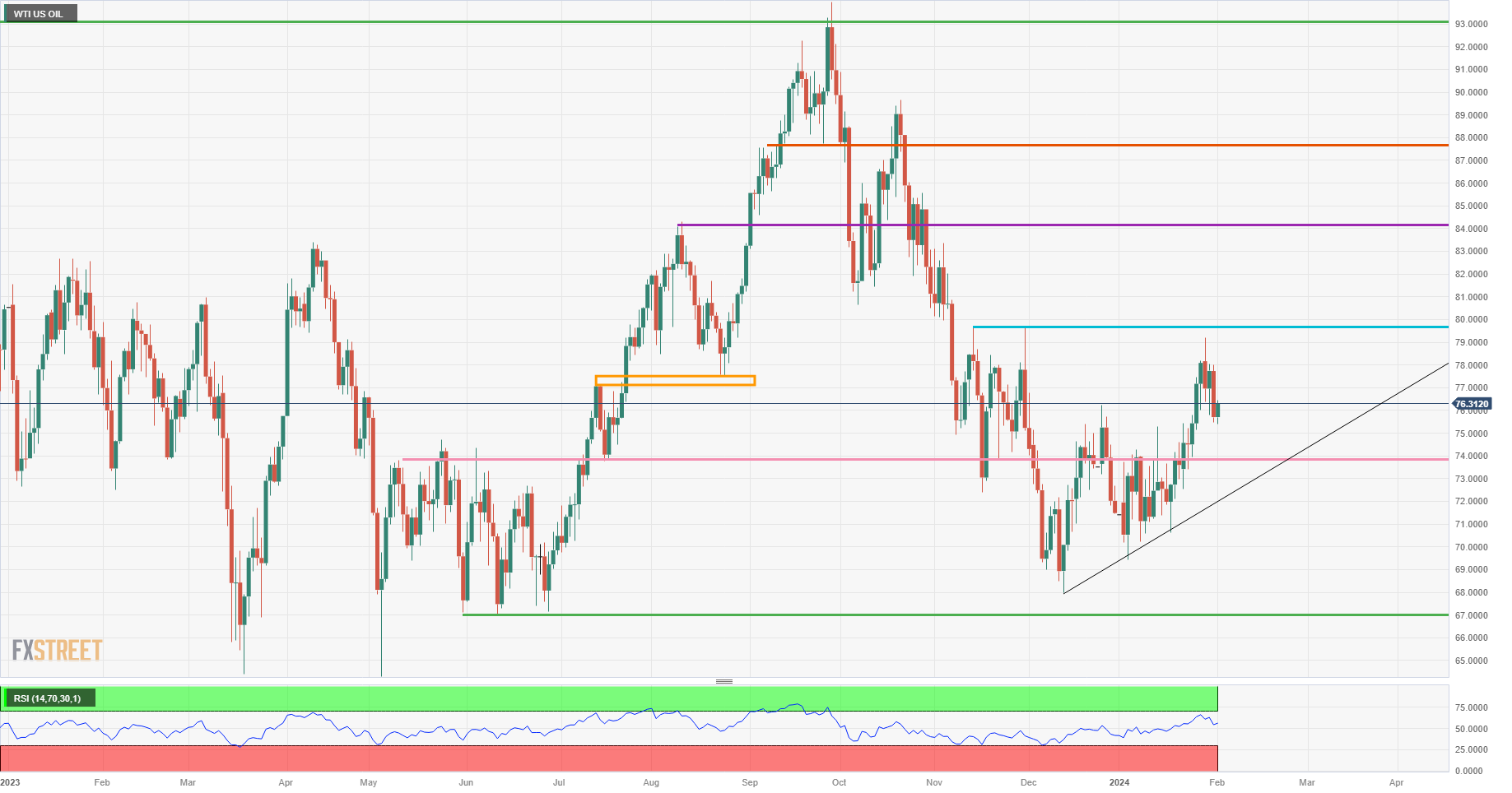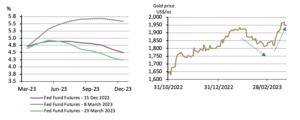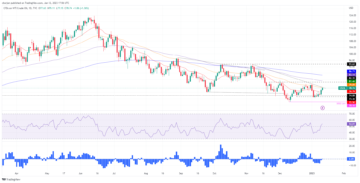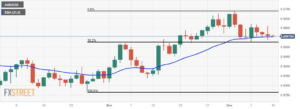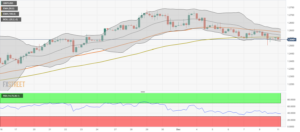- WTI Oil finds a floor for now near $76 in a sensitive market.
- Oil traders were caught by surprise by the EIA build of stockpile by 1.234 million barrels.
- The US Dollar Index sees post-Fed gains evaporating in fading price move.
Oil prices are finding a floor near $76, backed by the OPEC statement being released after the meeting earlier this Thursday. A panel of OPEC+ members said no policy changes are foreseen for now, while the US has reportedly hit a six-month high in November on production. Add the stockpile buildup number from the Energy Information Administration (EIA) overnight with a surprise build of 1.234 million barrels, and quick breach above $80 looks doubtfull.
Meanwhile, the US Dollar Index (DXY) is in the green, though momentum appears to be fading again. Although the US Federal Reserve Chairman Jerome Powell pushed back against a March rate cut possibility, he did not really do that for May or June. This means a small tweak in positions, with no substantial moves expected in the US Dollar further.
Crude Oil (WTI) trades at $76.57 per barrel, and Brent Oil trades at $81.29 per barrel at the time of writing.
Oil news and market movers: Nothing to see here
- Wednesday numbers from the Energy Information Administration threw a spanner in the works for Oil to soon head back to $80. While a drawdown was expected, the number came in at a buildup of 1.234 million against a drawdown of 9.233 million last week.
- The OPEC group has said in an online meeting that no further adjustments are needed for now, though production cutbanks are to considered an says its ready to intervene when needed.
- Russian arctic crude shipments have declined significantly after hitting a six-month high in December.
- A next domino might fall in the Chinese economy as Chinese oil refiners are seeing margins collapse under low demand and rising crude prices since the low of December.
- Bloomberg released numbers that showed the US produced a staggering 13.3 million barrels per day in November, making it a new monthly record.
Oil Technical Analysis: Sideways without additional measures
Oil prices, though picking up under the current news headlines, do not hold asmuch upside potential as markets think. Saudi Arabia’s woes about production levels appear to be a big threat for OPEC at a time when the group sees the US easily matching the current supply cuts by pumping more oil than it has been doing in the past years.
Although price action came very near, the $80 level will not be easy to beat. Once $80 is broken, $84 is next on the topside. A few dollars further, the red line near $87.66 comes into focus, though by then the Relative Strength Index (RSI) will likely be trading at overbought levels.
On the downside, the $74 level will act as immediate support for any sudden declines. The $67 level could still come into play as the next support as it aligns with a triple bottom from June. Should that triple bottom break, a new low could be close at $64.35 – the low of May and March 2023 – as the last line of defence.
US WTI Crude Oil: Daily Chart
WTI Oil FAQs
WTI Oil is a type of Crude Oil sold on international markets. The WTI stands for West Texas Intermediate, one of three major types including Brent and Dubai Crude. WTI is also referred to as “light” and “sweet” because of its relatively low gravity and sulfur content respectively. It is considered a high quality Oil that is easily refined. It is sourced in the United States and distributed via the Cushing hub, which is considered “The Pipeline Crossroads of the World”. It is a benchmark for the Oil market and WTI price is frequently quoted in the media.
Like all assets, supply and demand are the key drivers of WTI Oil price. As such, global growth can be a driver of increased demand and vice versa for weak global growth. Political instability, wars, and sanctions can disrupt supply and impact prices. The decisions of OPEC, a group of major Oil-producing countries, is another key driver of price. The value of the US Dollar influences the price of WTI Crude Oil, since Oil is predominantly traded in US Dollars, thus a weaker US Dollar can make Oil more affordable and vice versa.
The weekly Oil inventory reports published by the American Petroleum Institute (API) and the Energy Information Agency (EIA) impact the price of WTI Oil. Changes in inventories reflect fluctuating supply and demand. If the data shows a drop in inventories it can indicate increased demand, pushing up Oil price. Higher inventories can reflect increased supply, pushing down prices. API’s report is published every Tuesday and EIA’s the day after. Their results are usually similar, falling within 1% of each other 75% of the time. The EIA data is considered more reliable, since it is a government agency.
OPEC (Organization of the Petroleum Exporting Countries) is a group of 13 Oil-producing nations who collectively decide production quotas for member countries at twice-yearly meetings. Their decisions often impact WTI Oil prices. When OPEC decides to lower quotas, it can tighten supply, pushing up Oil prices. When OPEC increases production, it has the opposite effect. OPEC+ refers to an expanded group that includes ten extra non-OPEC members, the most notable of which is Russia.
- SEO Powered Content & PR Distribution. Get Amplified Today.
- PlatoData.Network Vertical Generative Ai. Empower Yourself. Access Here.
- PlatoAiStream. Web3 Intelligence. Knowledge Amplified. Access Here.
- PlatoESG. Carbon, CleanTech, Energy, Environment, Solar, Waste Management. Access Here.
- PlatoHealth. Biotech and Clinical Trials Intelligence. Access Here.
- Source: https://www.fxstreet.com/news/oil-finds-floor-near-76-after-unexpected-increase-in-us-stockpiles-202402011145
- :has
- :is
- :not
- $UP
- 1
- 12
- 13
- 2023
- 32
- 35%
- 66
- 9
- a
- About
- above
- Act
- Action
- add
- Additional
- adjustments
- administration
- affordable
- After
- again
- against
- agency
- Aligns
- All
- also
- Although
- American
- an
- analysis
- and
- Animate
- Another
- any
- api
- appear
- appears
- arctic
- ARE
- AS
- Assets
- At
- back
- backed
- barrels
- BE
- beat
- because
- been
- being
- Benchmark
- Big
- Bottom
- breach
- Break
- brent
- Broken
- build
- by
- came
- CAN
- caught
- Changes
- Chart
- chinese
- Close
- Collapse
- collectively
- come
- comes
- considered
- content
- could
- countries
- Crossroads
- crude
- Crude oil
- Current
- Cut
- cuts
- daily
- data
- day
- December
- decide
- decisions
- Declines
- defence
- Demand
- DID
- Disrupt
- distributed
- do
- doing
- Dollar
- dollar index
- dollars
- down
- downside
- driver
- drivers
- Drop
- Dubai
- Dxy
- each
- Earlier
- easily
- easy
- economy
- effect
- EIA
- ends
- energy
- Every
- expanded
- expected
- extra
- Fall
- Falling
- FAQ
- Federal
- federal reserve
- few
- finding
- finds
- Floor
- Focus
- For
- frequently
- from
- further
- Gains
- Global
- Government
- gravity
- Green
- Group
- Growth
- Have
- he
- head
- Headlines
- High
- higher
- Hit
- hitting
- hold
- HTTPS
- Hub
- if
- immediate
- Impact
- in
- includes
- Including
- increased
- Increases
- index
- indicate
- information
- instability
- Institute
- Intermediate
- International
- intervene
- into
- inventory
- IT
- ITS
- jerome
- june
- Key
- Last
- Level
- levels
- likely
- Line
- LOOKS
- Low
- lower
- major
- make
- Making
- March
- margins
- Market
- Markets
- matching
- May..
- means
- Media
- meeting
- meetings
- member
- Members
- might
- million
- module
- Momentum
- monthly
- more
- most
- move
- Movers
- moves
- Nations
- Near
- needed
- New
- news
- next
- no
- notable
- nothing
- November
- now
- number
- numbers
- of
- often
- Oil
- oil price
- on
- once
- ONE
- online
- opec
- opposite
- or
- organization
- Other
- overnight
- panel
- past
- pause
- per
- Petroleum
- picking
- pipeline
- plato
- Plato Data Intelligence
- PlatoData
- Play
- policy
- political
- Pops
- positions
- possibility
- potential
- predominantly
- price
- PRICE ACTION
- Prices
- Produced
- Production
- published
- pumping
- pushed
- Pushing
- quality
- Quick
- Rate
- ready
- really
- record
- Red
- referred
- refers
- refined
- reflect
- relative
- relative strength index
- Relative Strength Index (RSI)
- relatively
- released
- reliable
- report
- reportedly
- Reports
- Reserve
- respectively
- Results
- rising
- rsi
- Russia
- Said
- Sanctions
- Saudi
- says
- see
- seeing
- sees
- sensitive
- should
- showed
- Shows
- sideways
- significantly
- similar
- since
- small
- sold
- Soon
- sourced
- staggering
- stands
- starts
- Statement
- States
- Still
- strength
- substantial
- such
- sudden
- supply
- Supply and Demand
- support
- surprise
- Technical
- Technical Analysis
- ten
- texas
- than
- that
- The
- The US Federal Reserve
- their
- then
- think
- this
- though?
- threat
- three
- thursday
- Thus
- tighten
- time
- to
- traded
- Traders
- trades
- Trading
- Triple
- Tuesday
- tweak
- type
- types
- under
- United
- United States
- Upside
- us
- US Dollar
- US Dollar Index
- US Dollars
- US Federal
- us federal reserve
- US oil
- usually
- value
- very
- via
- vice
- was
- weaker
- week
- weekly
- were
- West
- when
- which
- while
- WHO
- will
- with
- within
- without
- works
- writing
- WTI
- WTI Crude
- years
- zephyrnet

